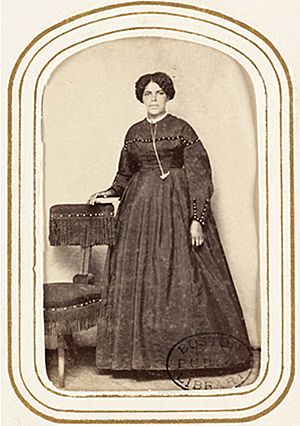Isabella Gibbons facts for kids
Quick facts for kids
Isabella Gibbons
|
|
|---|---|
 |
|
| Born | c. 1836 |
| Died | February 4, 1890 (about 54 years old) Washington, D.C.
|
| Burial place | Charlottesville, Virginia |
| Other names | Isabella Gibbins |
| Occupation | Acted as Nurse during civil war, Teacher |
| Years active | 1866–1874 |
| Known for | Her eyes on the Memorial to Enslaved Laborers |
| Spouse(s) | William Gibbons |
Isabella Gibbons (born around 1836 – died February 4, 1890) was an enslaved woman. She worked as a cook at the University of Virginia in Charlottesville, Virginia. After she gained her freedom in 1865, she became a teacher.
Contents
Life as an Enslaved Person
Isabella's exact birth date, birthplace, and parents are not known. Around 1850, she was bought by William Barton Rogers. He was a professor of natural philosophy (science) at the University of Virginia. Isabella worked as a cook for his family until 1853.
It seems that Mrs. Rogers taught Isabella how to read. In the early 1850s, Isabella married William Gibbons. He was also an enslaved worker owned by a university professor. They had four children together, and one of them was named Bella.
In 1853, another professor, Francis Henry Smith, took over from Rogers. Isabella continued to work as a cook for Smith's family until 1863. During the American Civil War, she also worked as a nurse. She helped care for people at the Confederate military hospital. This hospital was set up at the University.
Freedom and Teaching Career
Isabella and her husband became free on March 3, 1865. This happened when General Philip Sheridan's troops arrived in Charlottesville. They brought the news of the Emancipation Proclamation, which declared enslaved people free. This day is now known as Liberation and Freedom Day.
After gaining her freedom, Isabella became a teacher at the Freedmen's School. This school helped formerly enslaved people get an education. Today, the Jefferson School is a direct descendant of that original school.
Newspaper reports from that time spoke highly of Isabella. One report said:
We have four teachers at Charlottesville, and Miss Anna Gardner has taken the more advanced pupils whom she is forming into a normal [teacher training] class. One of her pupils has also aided her in teaching, Mrs. Isabella Gibbins. Although the mother of several children, whom she must aid in supporting, she wishes to perfect her own education and become a teacher of her people. She is doubly precious to our hearts, as the devoted nurse of one of the noblest and best-beloved of our young officers, who died a prisoner in rebel hands.
Isabella received similar praise in 1867 and 1869. The last time she was mentioned as a teacher in Charlottesville was in 1874.
Isabella's Powerful Letter
The only known writing by Isabella is a letter. It was published in a journal by the New England Freedman's Aid Society. This charity helped support schools for freed people. In all mentions of her in this publication, her name appeared as Gibbins.
Here is a part of her letter from March 29, 1867:
CHARLOTTESVILLE, Va., March 29, 1867.
DEAR LADY,—We have lived to see the fortieth Congress and to behold a change of affairs. The rebels begin to see the error of their way at last, and do all they can to better our race. They say the colored people are not only free but have a right to vote. Now let us be kind to them; they have been our slaves, and we must do something for them. It will not do to leave them to the care of those hated yankees. They will build them up as a tower against us. We must not do as we would like, but as we must, in this time of trouble, because the time that the Garrisons, the Sumners, and Stevens have been telling them about, has come, they will believe it if we do not take right steps in time. They are a good people, and so fond of their old masters, they will do what we want they should. Most of them love us, and have forgotten what happened while they were slaves. They know we are their friends.
This is a grand story for them to tell, but let us answer them. Can we forget the crack of the whip, cowhide, whipping-post, the auction-block, the hand-cuffs, the [manacles], the iron collar, the negro-trader tearing the young child from its mother’s breast as a whelp from the lioness? Have we forgotten that by those horrible cruelties, hundreds of our race have been killed? No, we have not, nor ever will.
If the Northern people who have given their life’s blood for our liberty are not our friends, where can we find them? O, God help us to love these people.
I am with the warmest regards,
Your servant,
ISABELLA GIBBINS
The sentences in italic from her letter are very important. They are carved into the Memorial to Enslaved Laborers at the University of Virginia in Charlottesville. Also, Isabella's eyes from the photograph in her infobox are etched onto the outside of this memorial.
Isabella's Legacy
- In 2015, the University of Virginia honored Isabella and William Gibbons. They named a new student residence hall "Gibbons House." Inside, there are photos of them and information panels. A plaque also tells their story.
- Isabella's eyes, taken from her only known photograph, are etched on the outside of the Memorial to Enslaved Laborers. The powerful quote from her letter is also inscribed there.

